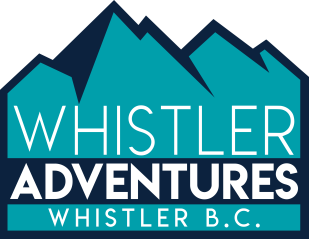Backcountry Snowboarding | Know Before You Go
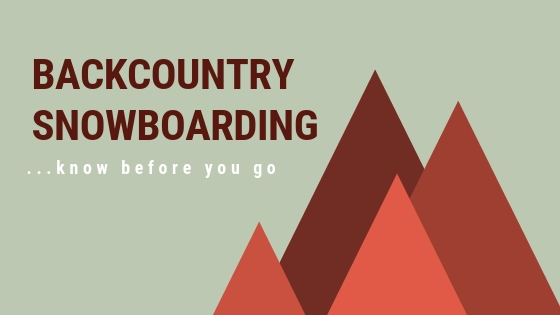
For anyone that’s strapped on a snowboard, you know there’s nothing quite like being the first to carve your way through open expanses of fresh, untouched, pillowy powder.
Leaving first tracks on a mountain feels like you’ve scored your own piece of heaven on earth (thank you snow gods!).
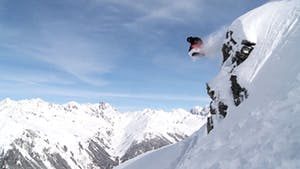
Ready, set, shred.
And if you’ve ever had your sights on some of Whistler Blackcomb’s fresh powder, then you know it means being up at the crack of dawn, ready to beat the crowds. An early rise is well worth the reward but there’s still another way you can skip the lineups while still getting your own piece of the Whistler-pow.
Let us introduce you to Whistler backcountry snowboarding.
With elevation gains of over 2,000 metres and snowboard terrain that stretches as far as the eye can see, it’s almost a crime not to experience Whistler backcountry for yourself.
For those of you that are craving the adventure, but not quite sure where to start. Here’s our take on ‘what to know before you go’ when taking on some of the best backcountry snowboarding in BC – or should we say North America.
Backcountry Essentials: What to Bring With You
The backcountry of British Columbia’s Coastal Mountains extend for hundreds of kilometres and are filled with breathtaking scenery complete with snowy peaks, dipping slopes, and ancient glaciers that are just waiting to be explored.
Planning for your backcountry trip isn’t something you can take lightly. In order to make the most of it – preparation is key.
Whether you heading out on day trip or a multi-day trek with a backcountry guide, here’s our list of essentials you should always have in your backpack.
- Splitboard (with skins)
- Extendable poles
- Avalanche safety kit (includes a transceiver beacon, prob, and extension shovel)
- A mountain-specific First Aid kit
- A backcountry Map/GPS
- Snacks and hydration
- Repair kit/tools (Leatherman, alan keyes, zip ties, duct tape, extra binding screws etc.)
- Headlamp with spare batteries
- Lighter/matches (waterproof)
- Survival blanket
- Sunscreen, chapstick with SPF
- Goggles/Sunglasses
- Down jacket or a waterproof/gore tex shell (with base layers)
- Cell phone
- A crew of awesome people (…because heading out in the backcountry alone is just plain dangerous).
Whistler Backcountry: the Snow Conditions
The backcountry snowboarding in BC is truly a year-round destination – but if it’s powder you’re looking for you’re going to find the best conditions from late December to late March. Whistler Blackcomb alone receives an average annual snowfall of about 11.7 metres, so once you reach the higher backcountry altitudes, you’re more likely to find yourself deep in the white stuff.
The extra perk to snowboarding the Whistler’s backcountry? Snow is going to stick around well after you say farewell to old man winter. Even during the shoulder seasons and spring and summer, if you work for it, you can still get access to elevated slopes and glaciers which make for a taste of your own backcountry lines, complete with warmer temperatures and bluebird skies.
Whistler Backcountry: The Weather at the Top
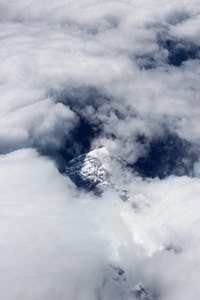
The weather turns quickly in the mountains. Pack for sun, snow, and storms.
Whistler’s backcountry weather conditions and as friendly as they are harsh. Always expect the unexpected. Bluebird days can turn into brutal winter storms in a matter of hours. Your morning could start with sunshine and blue skies followed by sleet, snow, and whiteout conditions in the afternoon.
The average Whistler alpine temperatures during the winter months sit between -12°C to -5°C from December to February and -8°C to +5°C from March to May. But with powerful alpine winds that can reach up to a 100km/hr at the higher elevations, a frosty -8°C can feel more like a bone-chilling minus 40°C!
Given the unpredictability of backcountry weather, It’s always essential to check the extended weather forecast before heading out on your adventure.
Whistler Backcountry Safety
Whistler’s backcountry topography can vary just as much as its weather patterns. Undulating slopes lead you through sparse alpine forests and up harsh mountainous ranges topped with steep, glaciated summits.
Making the most of this mighty expense however, can come at a cost. The terrain can be intense, wild, unpredictable, and vast. No matter how experienced you are as a snowboarder, you’re always at the mercy of the mountain. Even the most advanced riders are no match for an avalanche when tons of snow come bellowing down at speeds of up to 90 km/hr.
On that note, mountain safety always comes first. Here are some reminders of what you should think about before carving your first backcountry turns.
- Get your avalanche knowledge is up to scratch (know how to identify avalanche risks)
- Stay up to date with Whistler backcountry latest Avalanche Advisory rating
- Get certified with your official avalanche safety training
- Pack your avalanche safety gear (and know how to use it in case of emergency)
- Check the extended weather forecast as well as the latest snowfall, temperature, wind strength and visibility)
- Let someone know when you plan on leaving and returning from your trip
- Know how to get in contact with emergency services
- Travel with a group or an experienced guide
Why You Need a Backcountry Snowboarding Guide
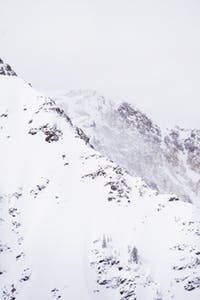
Don’t leave home without an experienced guide.
Beyond Whistler Blackcomb, there’s a fantastic bounty of backcountry snowboarding terrain just waiting to be explored — from mountain ranges that extend from Garibaldi Park, to the Brandywine Mountain area and beyond.
If you’re setting out to snowboard past the Whistler Blackcomb boundaries, taking an experienced guide with you is the way to go. Professional backcountry guides know the terrain, they’re experienced in avalanche safety and they make sure you have everything you need for a safe and memorable backcountry experience.
Whether you’re heading out on a full day trip or a multi-day adventure, an experienced guide will help you find the secret locations with the most epic powder and the most legendary scenery that you thought you could only dream of.
Top 5 Huts in the Whistler Backcountry
One of the perks of snowboarding at a resort like Whistler Blackcomb is that you can shred all morning and then pop into one of Whistler’s many mountain lodges, to warm up, grab a quick bite, and sip on a coffee or hot toddy to warm up.
In addition to dressing for the elements, there is another way you can find ‘shelter from the storm’ so to speak — take advantage another one of the backcountry’s hidden gems… Whistler Backcountry Huts.
The BC backcountry is scattered with dozens of huts where backcountry ski and snowboard enthusiasts can brush off the cold, hang out, refuel, and rest their heads for the night. Located on tenured land, these huts are run by private, commercial and non-profit organizations like the Alpine Club of Canada or government institutions such as BC Parks. Backcountry huts can range from a very basic shelter from the elements while others serve as your home-away-from-home — often equipped with basically all the basic amenities including bunk beds, cooking facilities, fireplaces, firewood, and outhouses.
The number of people that can stay at BC’s backcountry huts can vary, but many of them can sleep up to 40 people. Some of these locations can fill up quickly, so it’s always a bonus when you find a hut where you can pre-book to save your spot so you’re not disappointed. The private hut locations often arranged with guiding packages, while other public huts operate on a user-pay fee per night (to help with general maintenance fees).
- Wendy Thompson Hut
This modest, two-story hut offers a true backcountry experience and is located in the Marriot Basin are just north of Whistler. The hut features a gothic style arched design and can comfortably sleep up to 16 people. With recent renovations in 2017, the accommodations include basic cooking areas, tables, chairs, and a kitchen area. The hut is operated by ACC Whistler and can be booked via a new online reservation system with a very reasonable nightly rate of $15-$20.
- Callahan Country’s Journeyman Lodge
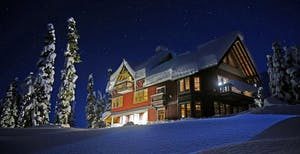
Nothing like a toasty-warm backcountry hut to warm the soul.
Journeyman Lodge is the grandfather of all backcountry huts in the Whistler region. This full-service chalet located in the heart of Whistler’s Callaghan area, and sits on over 12,000 hectares untouched backcountry terrain. Journeyman Lodge is more a resort-style experience that offers unique and customizable backcountry adventure packages. The hut can sleep up to 24 people and in addition to full catering services, it boasts other top-notch facilities including a wood-fired sauna and a games room.
- Himmelsbach Hut at Russet Lake
This hut is probably one of the most accessible huts in the Whistler backcountry area, located past the singing pass area outside the Whistler Mountain ski boundary. Himmelsbach Hut is a fairly quick and easy trip (from backcountry standards) and is smack in the middle of the majestic Fissile Mountain – where you can take advantage of dreamy turns through fresh powder. Expect basic facilities with a bench area for food prep, but with no heat, propane, or sinks. The hut is run by BC Parks and it sleeps up to six people. No reservations or fees required.
- Keith’s Hut (Cerise Creek)
This must-visit hut, located in Cerise Creek Wilderness Conservancy, just north of Whistler/Pemberton, and sits within close proximity some of the areas’ most sought after summits including Joffre, Mattier, and Vantage. The accommodations have all of the essentials of a backcountry hut including a wood stove, firewood, solar-powered light, a sink, an outhouse, and sleeping accommodation for up to 14 people. In exchange for a nights stay, donations are acceptable to help with basic maintenance and upkeep.
- Wedgemount Lake Hut
Although basic in amenities and modest in size, Wedgemount Lake Hut is worth an honourable mention due to its prime location in the Wedge Mountain area, adjacent to the shores of beautiful Wedgmount Lake. This hut can be accessed via a steep climb up from the parking lot at the end of Wedgemount Lake Road. Remember that this shelter is not heated, so bring your friends (up to eight max) and a good sleeping bag to stay warm.
…
They say “the best views come with the hardest climb” and that just about explains it when it comes to snowboarding in Whistler backcountry.
However you decide to get to the top, whether you’re strapping on the skins, or getting dropped by snowmobiles (or even a helicopter), we promise the journey into the backcountry is always worth the gloriously long lines you’ll get on the way down.
The mountains are calling…can you hear them?
